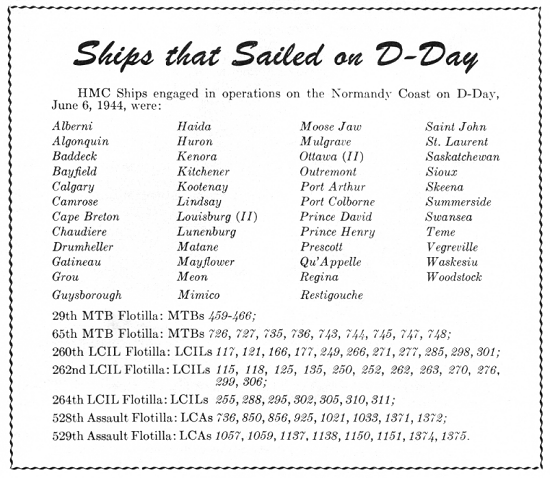THE RCN ON D-DAY
Page 5: D-Day the Sixth of June 1944
Originally
published in the "Crowsnest Magazine" Vol. 16 No. 5 May
1964
By Lt. Peter Ward, RCNR
|
|
|
|
|
The operation had been timed so darkness would be over the coast when the ‘sweepers came within sight of land.
In
pitch blackness the ‘sweepers finished clearing the anchorage
for transport and bombarding ships. They were 4.5 miles from shore
when at 1.05 am on D-Day they turned south and headed for the beaches
to sweep for the assault craft.
At
3 am, with the ships a scant 1.5 miles from shore, the moon broke
through clouds to bathe the ‘sweepers in a ghostly light. Men
at the sweeps, gunners and officers on the bridges held their breath,
waiting for the boom of shore batteries to blast them from the water
at point-blank range.
They were never seen. The moon slid back behind those protecting clouds and the ‘sweepers continued their perilous task. They finished at 5.15 am and headed out to sea.
AS
THEY REACHED the lanes they had swept to the assault anchorage,
the first of the attacking ships met them. They were the first of
a fleet of 6,000 ships. When those ships anchored off the beach,
packed as close as safety would allow, they made a solid line of
ships 60 miles long. They had crossed the Channel on a front 20
miles wide. The steady stream of ships was to continue for more
than a month as the Allies built up the strength that eventually
crushed Hitler’s Fortress Europe.
There
were more Canadian sailors in that huge fleet, some of them on board
ships which carried Canadian soldiers. The fleet had made an abortive
start June 4, only to be recalled in bad weather. Finally at noon
of June 5, seven large infantry landing craft of the 260th Flotilla
slipped and headed for their assembly point. The 260th was one of
three Canadian LCI(L) flotillas. Four remaining craft of the 260th
were held back in reserve. On board the attacking ships were 250
Canadian soldiers and 1.050 British troops, all attached to the
3rd Canadian Division.
Astern
of the 260th were 12 ships of the 262nd Flotilla, with 1,946 Canadians
and 148 British troops. Seven ships of the 264th Flotilla were there,
too, with 1,227 British troops.
The landing ships Prince David and Prince Henry, heavier and faster,
left behind the clumsy landing craft and passed them en route. Each
of the “Prince” ships was loaded with Canadian troops
and each led her own division of assault ships. The “Princes”
each carried a flotilla of assault craft.
All
Canadians troops were heading for Mike and Nan beaches in the Juno
sector. Craft of the 264th Flotilla, carrying British troops, went
to Gold Sector.
With the assault forces were the destroyers Algonquin and Sioux, both assigned to the bombarding force.
ON THAT FIRST DAY the ships of the biggest fleet ever assembled landed 90,723 troops on the beaches of Normandy. They put ashore 9,989 vehicles, and supplied the troops with 5,507 tons of food and ammunition.
>>> Go to Next Page
 |
